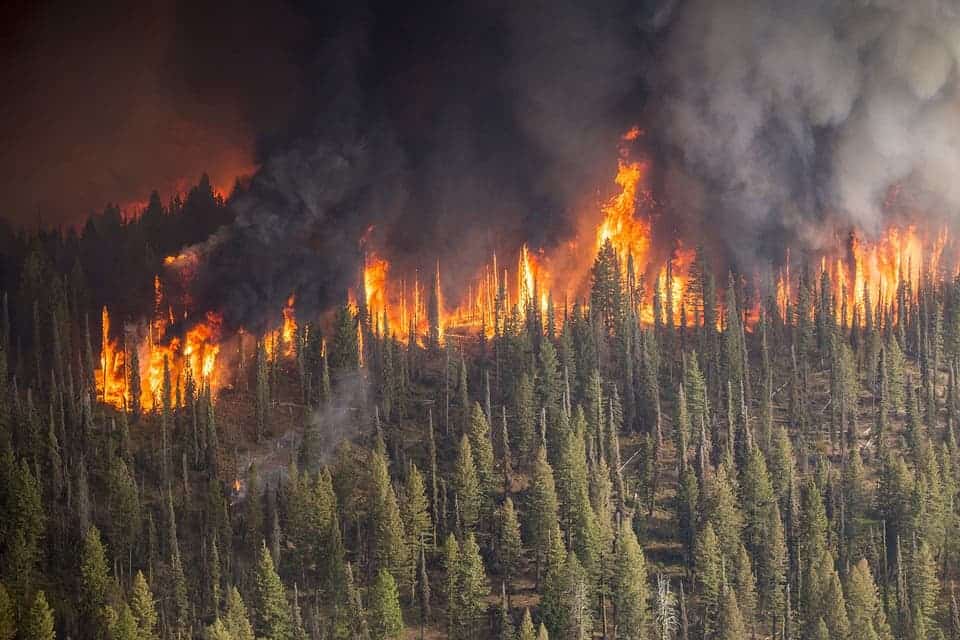Wildfires could, surprisingly, act as net carbon traps.

The charcoal produced by wildfires can keep carbon out of the atmosphere for hundreds of years, new research from the Swansea University suggests.. The findings will help us better model changes in climate, especially as warmer mean temperatures in the arctic are leading to an unprecedented outbreak of wildfires and CO2 release in the area.
Burned and buried
Wildfires generate a large quantity of CO2. Generally, however, the gas is re-captured as vegetation grows back, so wildfires are considered to be more or less carbon-neutral once this regrowth process is complete.
“However, in a fire some of the vegetation is not consumed by burning, but instead transformed to charcoal,” explains Dr. Matthew Jones, lead author of the paper who recently joined the University of East Anglia’s (UEA) School of Environmental Sciences from Swansea University.
“This carbon-rich material can be stored in soils and oceans over very long time periods. We have combined field studies, satellite data, and modelling to better quantify the amount of carbon that is placed into storage by fires at the global scale.”
On average, wildfires burn an area roughly equivalent to the size of India every year and emit more carbon dioxide than global road, rail, shipping, and air transport combined, the team explains. Given the increased occurrence of wildfires in the past few years, a trend which will likely pick up in our warmer, drier future, the team set out to quantify how much carbon this charcoal can sequester from the air. All in all, the team says that this charcoal could lock away a considerable amount of carbon for years to come.
Vegetation growing back in burned areas draws on atmospheric CO2 to grow (through photosynthesis). This stage of the fire-recovery cycle takes just a bit under a year for grasslands, up to several decades in fire-adapted forests. In extreme cases, such as we’re seeing today in the arctic or tropical peatlands, full recovery may not occur for centuries. The timing of this recovery is important because the carbon that is emitted during the fire stays in the atmosphere and contributes to climate heating. Plants recapture it as they mature.
Overall, grassland fires don’t have that great of an impact; deforestation fires, however, are a particularly important contributor to climate change. Forests produce a lot of emissions as they burn, and take a long time to regrow, resulting in a long-term injection of carbon to the atmosphere.
The team explains that the charcoal resulting from forest fires — known as pyrogenic carbon — plays a larger part in mitigating these emissions than we’ve assumed. While they do emit CO2 to the atmosphere, landscape fires also transfer a significant fraction of the carbon locked in the affected vegetation to charcoal and other charred materials. The researchers say the quantity of this pyrogenic carbon is significant enough that it needs to be considered in global fire emission models.
As this material gets covered in soil, it locks carbon in place. Given time for flora to recover, the process actually leads to a net loss of carbon in the atmosphere — which is what we want.
“Our results show that, globally, the production of pyrogenic carbon is equivalent to 12 % of CO2 emissions from fires and can be considered a significant buffer for landscape fire emissions,” Dr. Jones said.
“Climate warming is expected to increase the prevalence of wildfires in many regions, particularly in forests. This may lead to an overall increase in atmospheric CO2 emissions from wildfires, but also an increase in pyrogenic carbon storage. If vegetation is allowed to recover naturally then the emitted CO2 will be recaptured by regrowth in future decades, leaving behind an additional stock of pyrogenic carbon in soils, lakes and oceans.”
The pyrogenic carbon will eventually find its way back into the atmosphere as the charcoal degrades, but it takes centuries or even millennia to do so. In the meantime, all the carbon it contains doesn’t influence the climate. It isn’t enough to offset man-made emissions, but every bit helps.
“This brings some good news, although rising CO2 emissions caused by human activity, including deforestation and some peatland fires, continue to pose a serious threat to global climate,” Dr. Jones adds.
The findings showcase the importance of factoring in pyrogenic carbon production in future climate models and in the global carbon cycle. The team plans to continue researching how the warmer more drought-prone climate of the future is going to impact the global extent of wildfires and to more accurately estimate the proportion of CO2 emissions recaptured by future vegetation regrowth.
The paper “Global fire emissions buffered by the production of pyrogenic carbon” has been published in the journal Nature Geoscience.






